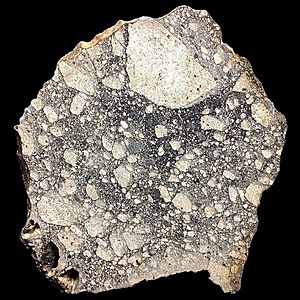Lunar meteorite facts for kids

A lunar meteorite is a special kind of meteorite that scientists are sure came from the Moon. Imagine a space rock hitting the Moon! Sometimes, this impact is so strong that it blasts pieces of the Moon's surface into space. These pieces then travel through space and can eventually land on Earth. When they do, we call them lunar meteorites.
Contents
How Do Lunar Meteorites Form?
Lunar meteorites start their journey when another space rock, like an asteroid or comet, crashes into the Moon. This crash creates a huge crater and sends Moon rocks flying out into space. These rocks become space travelers, orbiting the Sun for a long time. Eventually, some of these Moon rocks cross Earth's path and are pulled in by our planet's gravity. They fall through our atmosphere and land on the ground, becoming meteorites.
Finding Moon Rocks on Earth
Finding a lunar meteorite is very rare! Most meteorites found on Earth come from asteroids. Scientists look for lunar meteorites in places where they are easier to spot, like deserts or icy areas. The Sahara desert and Antarctica are common places where these special rocks are found. In these places, the dark meteorites stand out against the light sand or white ice.
How Scientists Identify Them
It's not easy to tell a Moon rock from an Earth rock just by looking at it. Scientists use special tests to identify lunar meteorites. They compare the rocks' minerals and chemical makeup to samples brought back from the Moon by Apollo missions. If the rock's composition matches the Moon samples, then it's confirmed as a lunar meteorite. These rocks often have unique textures and minerals that are different from Earth rocks.
Why Lunar Meteorites Are Important
Lunar meteorites are incredibly valuable to scientists. They are like free samples from the Moon! Since only a few places on the Moon have been explored by astronauts or robotic missions, these meteorites give us clues about other parts of the Moon. They help us learn about the Moon's history, how it formed, and what it's made of. By studying them, scientists can understand more about the early Solar System and how planets developed.
Images for kids
See also
 In Spanish: Meteorito lunar para niños
In Spanish: Meteorito lunar para niños


